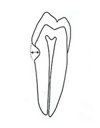1. Osborne-Smith KL, Burke FJ, Wilson NH. The aetiology of the non-carious cervical lesion. Int Dent J. 1999. 49:139–143.

2. Aw TC, Lepe X, Johnson GH, Mancl L. Characteristics of noncarious cervical lesions. A clinical investigation. J Am Dent Assoc. 2002. 133:725–733.
3. Levitch LC, Bader JD, Shugars DA, Heymann HO. Non-carious cervical lesions. J Dent. 1994. 22:195–207.

4. Sangnes G, Gjermo P. Prevalence of oral soft tissue and hard tissue lesions related to mechanical tooth cleansing procedures. Community Dent Oral Epidemiol. 1976. 4:77–83.

5. Hong FL, Nu ZY, Xie XM. Clinical classification and therapeutic design of dental cervical abrasion. Gerodontics. 1988. 4:101–103.
6. Donachie MA, Walls AW. Assessment of tooth wear in an ageing population. J Dent. 1995. 23:157–164.

7. Borcic J, Anic I, Urek MM, Ferreri S. The prevalence of non-carious cervical lesion in permanent dentition. J Oral Rehabil. 2004. 31:117–123.
8. Bader JD, McClure F, Scurria MS, Shugars DA, Heymann HO. Case-control study of non carious cervical lesions. Community Dent Oral Epidemiol. 1996. 24:286–291.
9. Piotrowski BT, Gillette WB, Hancock EB. Examining the prevalence and characteristics of abfractionlike cervical lesions in a population of U.S. verterans. J Am Dent Assoc. 2001. 132:1694–1701.

10. Tyas MJ. The class V lesion - aetiology and restoration. Aust Dent J. 1995. 40(3):197–170.

11. Cuenin M, Clem B. Periodontal and restorative treatment of class V lesion. Gen Dent. 1993. 41:252–254.
12. Litonjua LA, Andreana S, Bush PJ, Tobias TS. Noncarious cervical lesions and abfractions; a re-revaluation. J Am Dent Assoc. 2003. 134:845–850.
13. Grippo JO. Noncarious cervical lesions: The decision to ignore or restore. J Esthet Dent. 1992. 4:55–64.

14. Paolantonio M, D'ercole S, Perinetti G, et al. Clinical and microbiological effect of different restorative materials on the periodontal tissue adjacent to subgingival class V restorations. J Clin eriodontol. 2004. 31:200–207.

15. Larato DC. Influence of a composite resin restoration on the gingiva. J Prosthet Dent. 1972. 28:402–404.

16. Willershausen B, Köttgen C, Ernst CP. The influence of restorative materials on marginal gingiva. Eur J Med Res. 2001. 6:433–439.
17. van Dijken JW, Sjöström S, Wing K. The effect of different types of composite resin filling on marginal gingiva. J Clin Periodontol. 1987. 14:185–189.

18. Blank LW, Caffesse RG, Charbeneau GT. The gingival response to well-finished composite resin restorations. J Prosthet Dent. 1979. 42:626–632.

19. Seibert J, Lindhe J. Linde J, editor. Esthetics and periodontal therapy. Textbook of clinical periodontology. 1989. 2nd edition. Copenhagen: Munksgaard;477–514.
20. Schätzle M, Lang NP, Ånerud Å, et al. The influence of margins of restorations on the periodontal tissues over 26 yers. J Clin Periodontol. 2000. 27:57–64.
21. Jansson L, Blomster S, Forsgårdh A, et al. Interactory effect between marginal plaque and subgingival proximal restorations on periodontal pocket depth. Swed Dent J. 1997. 21:77–83.
22. Goerzo I, Newman HN, Strahan JD. Amalgam restorations, plaque removal and periodontal health. J Clin Periodontol. 1979. 6:98–105.

23. Laurell L, Rylander H, Pettersson B. The effect of different levels of polishing of amalgam restorations on the plaque retention and gingival inflammation. Swed Dent J. 1983. 7:45–53.








 PDF
PDF ePub
ePub Citation
Citation Print
Print








 XML Download
XML Download